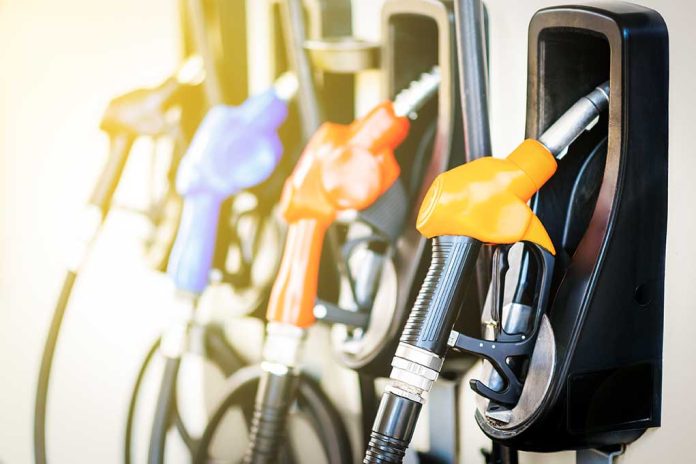
California drivers face a staggering potential $8.43 per gallon gas price by 2026 as Democrat lawmakers push forward with yet another tax hike while simultaneously shutting down critical refineries in their reckless pursuit of a green agenda.
Key Takeaways
- California’s new gas tax under the Low Carbon Fuel Standard will add 50-65 cents per gallon starting July 2025, on top of the already highest gas prices in the nation
- The scheduled closure of two major refineries (Phillips 66 in Los Angeles and Valero in Benicia) by 2026 will eliminate 20% of California’s gasoline production capacity
- Gas prices could skyrocket 75% to $8.43 per gallon by the end of 2026, according to USC Professor Michael Mische’s analysis
- Republican efforts to repeal the tax increase were defeated by the Democrat supermajority in an 18-39 Assembly vote
- The refinery closures could result in a daily gasoline deficit of up to 13.1 million gallons and cause the loss of over 4,000 direct and indirect jobs
Democrats Ram Through New Gas Tax Despite California’s Already Sky-High Prices
California’s Democrat-controlled legislature has approved a punishing new gas tax increase of 50 to 65 cents per gallon set to take effect in mid-2025. Implemented by the California Air Resources Board (CARB) under the updated Low Carbon Fuel Standard, this tax hike comes despite California already having the nation’s highest gas prices, currently averaging $4.78 per gallon for regular grade. Republican attempts to halt the increase through Assembly Bill 12 were soundly defeated in an 18-39 vote, highlighting the Democratic supermajority’s determination to advance their climate agenda regardless of the economic impact on working Californians.
Making matters worse, the state’s Department of Tax and Fee Administration recently announced another increase in the state’s gas excise tax to 61.2 cents per gallon, effective July 1. When combined with the upcoming LCFS regulations, Californians face a perfect storm of fuel price increases. CARB’s actions have drawn sharp criticism after Chair Liane Randolph admitted during legislative questioning that the board failed to consider the economic impact of its regulations on gas prices before implementation – an omission that demonstrates the environmental agency’s disconnect from economic realities facing everyday Californians.
Refinery Closures Set to Create Fuel Supply Crisis
The tax increase is only part of California’s impending fuel price disaster. Two major refineries – Phillips 66 in Los Angeles and Valero in Benicia – are scheduled to shut down by the end of 2025 and April 2026 respectively. These facilities currently produce approximately 20% of California’s gasoline supply, and their closure will create a massive production shortfall. Senate Minority Leader Brian W. Jones has warned that the state faces a looming energy and economic crisis due to these planned shutdowns, which have been driven in large part by Governor Gavin Newsom’s hostile regulatory policies toward fossil fuel production.
“We’re talking about gas prices over $8.43 per gallon by the end of next year. Let’s be clear: Newsom owns this gas crisis. His policies have made it nearly impossible for California refineries to stay open. As Newsom eyes the White House, America should be watching closely: the crisis he created here could be the next national nightmare,” Said Leader Jones
The economic impact extends far beyond just higher pump prices. The refinery closures will result in significant job losses, affecting approximately 1,300 direct employees and nearly 3,000 indirect jobs. This employment crisis will hit working-class families precisely when they are already struggling with inflation and rising living costs. The state will also become increasingly dependent on out-of-state and foreign fuel sources, introducing supply chain vulnerabilities and potential national security concerns – all while doing nothing to reduce global carbon emissions.
Economic Analysis Projects Devastating Impact Across Multiple Industries
A comprehensive study by USC professor Michael A. Mische paints a grim picture of California’s economic future under these policies. His analysis projects a gasoline deficit of 6.6 to 13.1 million gallons daily once both refineries close. This massive supply reduction, combined with the new tax increases and other regulatory burdens, could drive gas prices up by as much as 75% from current levels by the end of 2026. The ripple effects will impact virtually every sector of California’s economy, particularly those dependent on transportation.
“Reductions in fuel supplies of this magnitude will resonate throughout multiple supply chains affecting production, costs, and prices across many industries, such as air travel, food delivery, agricultural production, manufacturing, electrical-power generation, distribution, groceries, and health care,” Said Michael A. Mische.
Senate Republicans, led by Brian Jones, have vowed to continue fighting against these gas price hikes, but face steep obstacles with Democrats controlling both legislative chambers and the governor’s office. Jones forced a Senate floor vote to repeal the 65-cent gas price increase, but Senate Democrats unanimously opposed it. The political battle lines are clearly drawn, with Republicans standing for affordability and economic security while Democrats prioritize their environmental agenda regardless of the crushing financial burden it places on California families who are already fleeing the state in record numbers.







